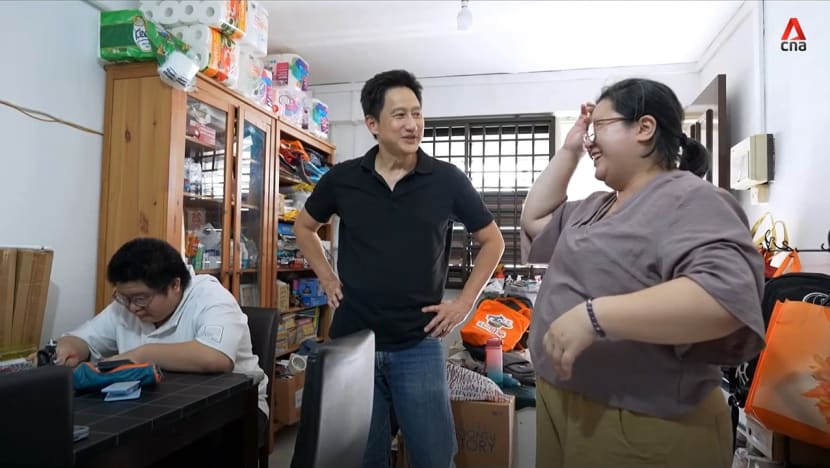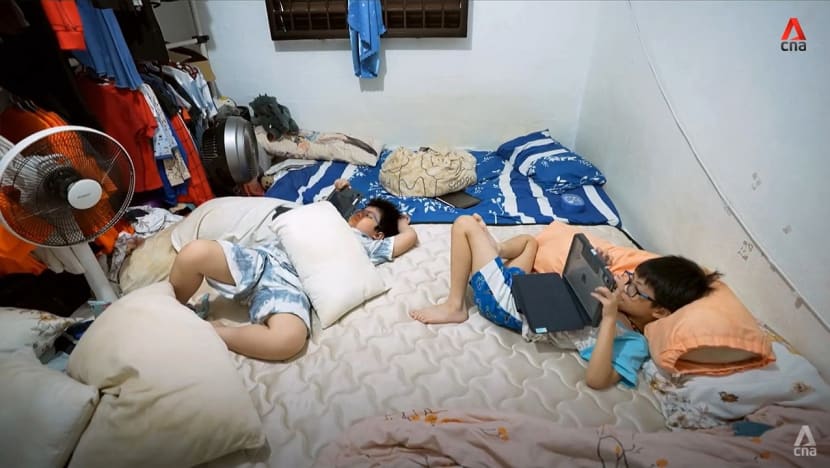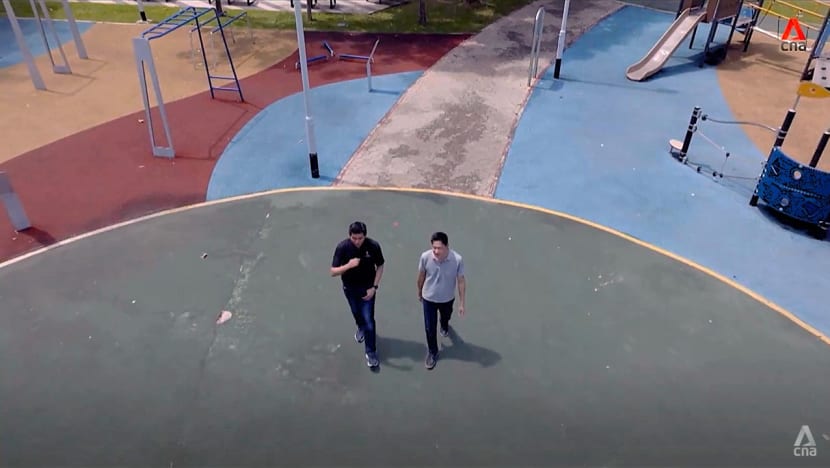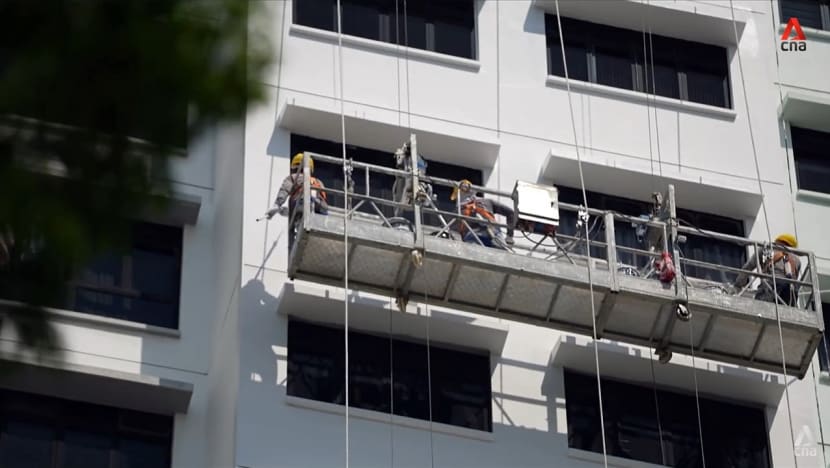How to beat the heat in Singapore, without air-conditioning
About 20 per cent of Singapore’s resident households do not have an air-conditioner. What is their life like struggling with heat? The programme Talking Point shares one family’s experience and gets cooling advice from a team of experts.

Talking Point host Steven Chia finds out how one family living in a two-room rental flat has tried to cope with the heat.

This audio is generated by an AI tool.
SINGAPORE: Single mother Fion Lim has been trying to get an air-conditioner through her social worker.
Although it would mean higher electricity bills, she only wants her three boys to “rest properly” in their two-room rental flat in Jurong West.
She has four fans — one in the living room and three in the bedroom. But there have been times when it was still stuffy. “My boys will complain that it’s too hot for them to fall asleep,” she said.
Two of her boys have eczema, and they tend to itch because of sweat, especially her eldest, who would “wake up in the middle of the night”, she added.
Even with the extra fans she bought recently — using the S$300 climate vouchers all Housing and Development Board (HDB) households can claim for purchases of energy- and water-efficient products — her family has struggled to cope with Singapore’s rising temperatures.

“Sometimes my boys will … be topless because of the hot weather,” she said. “They’ll (say), ‘Mum, I don’t want to wear my shirt. I’m sweating.’”
About 20 per cent of all resident households in Singapore do not have an air-conditioner, according to the Department of Statistics.
But just how is the weather hitting some of them harder, where are they located and what can be done to beat the heat?
AREAS WITH HIGH HEAT RISK
One man who knows where the most vulnerable areas are and why is Winston Chow, a professor of urban climate at the Singapore Management University and the first Singaporean elected to the United Nations’ top climate body.

He showed the programme Talking Point a heat map of Singapore in May, when the mean daily temperature was about 29 to 30 degrees Celsius.
Some parts of the island were slightly hotter than others: Jurong was one of them, and in the east, regions such as Bedok, Changi, Geylang, Kallang, Marine Parade, Tampines and Tanah Merah.
Chow also took presenter Steven Chia to a neighbourhood in Boon Keng, where they found, using a thermal camera, that the afternoon temperature of the ground was about 50 deg C.
“You see the high-rise, high-density public housing,” noted Chow. “You don’t have many trees … so you’ve got less shade.”
With vehicles on the road burning petrol and diesel, “a lot of waste heat” is also emitted. And heat trapped by the urban jungle is re-radiated out into the atmosphere.

Indeed, temperatures in Boon Keng are a couple of degrees Celsius warmer than in Bukit Timah, he said, identifying the latter as “one of the coolest places in Singapore to live”.
For example, in Old Holland Road, where “there’s less concrete, there’s less asphalt, more grass, large gardens”, he described, its green spaces “cool the environment substantially”.
Physical exposure to heat is one factor in heat vulnerability. Another is the concentration of the elderly population, who are more at risk of heat stress or heat stroke.
And fewer elderly people live in Bukit Timah than, say, Clementi, which was built up in the 1970s and 80s. Residents in mature HDB estates “tend to stay there for the duration of their lives”, noted Chow.
The third factor is income: People who are unemployed or have below-average incomes have fewer resources or finances to keep cool.
WATCH: Can we beat the heat without air-conditioning? (23:23)
“If you think twice about turning on the air-con, you tend to be more at risk of being exposed to heat,” said Chow.
These factors combine to make Geylang, Jurong West and Kallang three of Singapore’s neighbourhoods that are arguably most vulnerable to heat.
HOW A REDESIGN CAN COOL A FLAT
There are ways to beat the heat without moving house, however, and without air-conditioning.
Experts have embarked on the three-year Climate Resilient Citizenry project to study how Singaporean households cope with heat and to develop new, cheaper cooling strategies. And how the researchers helped Lim’s family was instructive.
The team found that the air in her flat was stagnant. “The house is so small,” noted Singapore University of Technology and Design (SUTD) architecture and sustainable design lecturer Zheng Kai. The clutter in the flat was also blocking wind flow.

In the bedroom, the family’s clothes were hanging behind the fans, reducing the wind that was produced and recirculating hot air, he observed.
They were also using bed sheets made of synthetic material, “which isn’t that cooling”, said Singapore-ETH Centre postdoctoral researcher Natalia Borzino.
In the hall, the fridge was not in the best spot. A thermal camera showed that it was almost 6 to 7 deg C warmer where the fridge was, compared to its surroundings.
Every electrical appliance releases heat and can heat up a home, Zheng said. So the Talking Point team moved the fridge and induction hob further away from the bedroom.
The bedroom fans were moved next to the window, to better circulate fresh air. The team also helped the family declutter and tidy up the flat to allow for better ventilation.
And they installed blinds instead of curtains, for both privacy and ventilation.
As for other items the family needed, the researchers suggested a wardrobe to put the clothes in and make the bedroom airier, cotton bed sheets — which are “more breathable and cooling”, cited Borzino — and an air cooler.
An air cooler is like a fan but blows cooler air because of water evaporation. It can bring down temperatures by at least 2 to 3 deg C, cited Zheng.
Its energy consumption is about a tenth of the energy typically used up by air-con, he added.
It need not break the bank either. Digital platform GoodHood.SG helps match people looking for specific items with those looking to give them away, and donors had given it an air cooler, cotton sheets and a new foldable mattress.

Most of its requesters, meanwhile, live in rental flats. There are also Community Health Assist Scheme cardholders in the blue and orange tiers — roughly the bottom 30 per cent by average income per household member — asking for items.
Requests for cooling systems and dri-fit clothes have increased lately and will continue increasing, reckoned GoodHood.SG founder Nigel Teo, because of the hot weather.
FROM HOME FIXES TO TOWN PLANNING
Beyond the fixes a household can make, Talking Point found out what is being done to cool down HDB towns, including future ones.
The HDB demonstrated its modelling tool, which chief sustainability officer Tan Sze Tiong said enables its planners to “simulate the various environmental parameters and their combined effect on developments”.

What this means is that before construction begins, “we can have this trial and error in the virtual world”, elaborated HDB executive engineer Eng Yong.
He cited Punggol’s Northshore district, where buildings were designed in a “certain arrangement that helps the wind to penetrate easily into the whole district”.
The way the blocks were built, the number of trees and where the shade hits the playgrounds — all these were designed with the modelling tool to maximise cooling in the neighbourhood.
Over in Tampines, there is a pilot scheme to test the effectiveness of a heat-reflective paint in helping buildings “absorb less heat in the day and emit less heat at night”, cited HDB senior engineer Alex Yeo.

The aim is to reduce ambient temperature by up to 2 deg C on a sunny day. About 60 blocks have been painted, and 130 blocks are scheduled to be completed by year end.
If the scheme is successful, eventually this coating could be used on all HDB blocks when they are repainted, affirmed Yeo.
While this is a work in progress, one cooling intervention that is already paying off are the changes made to Lim’s flat.
She reported that the bedroom “feels a lot less stuffy”. “My boys love the bed sheet. They say it’s comfortable,” she added. “They can sleep better at night.”
What her eldest son, Austin Tan, likes best are the blinds, as they get more privacy but still have air coming in, compared with curtains. Still, his mother feels it would be better to have air-con.

As far as the researchers are concerned, their solutions have proved a success. A fortnight after they first visited the family, they recorded a temperature of 29.8 deg C, down from the previous reading of around 32 deg C.
The wind speed was 0.4 metres per second, compared with 0.0 m/sec previously. Zheng called this a “very good improvement”.
“It’s significantly cooler than what conditions were before,” said Samuel Chng, a senior research fellow at the SUTD’s Lee Kuan Yew Centre for Innovative Cities.
“In the context of rising urban heat, … what we’ve done in Fion’s home is something that every household in Singapore is able to adopt.”
Watch this episode of Talking Point here. The programme airs on Channel 5 every Thursday at 9:30 p.m.




















